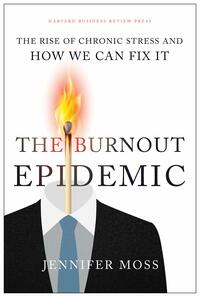Take a photo of a barcode or cover
34 reviews for:
The Burnout Epidemic: The Rise of Chronic Stress and How We Can Fix It
Jennifer Moss
34 reviews for:
The Burnout Epidemic: The Rise of Chronic Stress and How We Can Fix It
Jennifer Moss
This book is actually probably quite good... IF (and that's a huge if) you're in a position of leadership within an organization. I was not the target audience, and in fact have had a parade of experiences with leaders who desperately (DES.PER.AT.ELY) need to read this book. Finishing it meant spending some 235 pages feeling bereft over how much my own working experiences have lacked the emotionally intelligent, empathetic, and wellness-focused leadership Moss describes. I could not have read this book at a worse time; it picked at the scabs on wounds I'm actively trying to heal. So take that for what you will. My review is a classic "it's-me-not-you" situation.
.
These two lines about how COVID caused many of us to grieve things we lost (including the lives we once lived with carefree abandon) absolutely slayed my heart, and not in the good way: "In the workplace, grief can cause people to be more disorganized, withdrawn, or anxious. Unfortunately, if leaders lack empathy, they miscalculate these behaviors as performance problems instead of analyzing what is going on behind the late arrivals or less-than-perfect work" (p. 189).
.
Hi, trauma. I see you.
.
These two lines about how COVID caused many of us to grieve things we lost (including the lives we once lived with carefree abandon) absolutely slayed my heart, and not in the good way: "In the workplace, grief can cause people to be more disorganized, withdrawn, or anxious. Unfortunately, if leaders lack empathy, they miscalculate these behaviors as performance problems instead of analyzing what is going on behind the late arrivals or less-than-perfect work" (p. 189).
.
Hi, trauma. I see you.
Burnout is much larger in businesses, academia, and many other places than we recognize. Simple fixes will not make it go away. You cannot self-care away burnout. We have to develop institutional and widespread tactics to battle it. Jennifer Moss does a great job explaining and talking about how to overcome this epidemic.
Descriptions of burnout are spot on but I came away with no new strategies or ways to prevent it for me or my team.
challenging
hopeful
informative
medium-paced
The book felt highly repetitive. It spent a majority of the time defining burnout and emphasizing the importance of the burnout problem without providing concrete solutions.
informative
slow-paced
I read this book in preparation for a presentation on burnout to my organization, and it was excellent. It clearly outlined the 6 main causes of burnout, placing the onus on the system, organization, or institution instead of the individual. It did a great job of going into further detail and explaining each of the causes and providing examples. Sometimes the examples didn't necessarily feel like a direct tie to the cause - which is my only complaint about the book. Overall, it gave me a comprehensive textbook knowledge of burnout.
informative
medium-paced
This book starts out strong but gets weaker over time. The introduction and first chapter set out a strong foundation. The highlight how the COVID-19 pandemic exacerbated burnout, transforming it from a chronic issue into an epidemic. What I liked about the first part of this book is that it clearly frames burnout as an organizational concern with significant human and financial costs, not an individual problem. Burnout is a gradual process, not a sudden occurrence. Under chronic stress, our coping skills slowly erode.
Burnout is presented in the context of dual-factor motivation-hygiene theory. For people to be happy and effective, the organization needs to provide factors which both motivate and which prevent burnout. These factors are not opposites but rather independent. Often the people who are most motivated can be the ones most at risk for burnout. Empathetic leadership that sees burnout as a systemic problem is necessary to combat burnout.
There are six key factors that contribute to burnout. An overloaded workload is the most important contributor. Addressing this requires organizations to scrutinize actual workloads by clarifying expectations, leveraging strengths, providing training, and adequately resourcing projects. They should not resort to superficial solutions, which may simply postpone stress.
A perceived lack of autonomy can be reduced by reducing micromanagement and granting employees more autonomy over their scheduling and task execution. Burnout is exacerbated by a lack of reward or recognition; even when there's monetary recognition, the emotional toll of extra workload is often not recognized. When people have poor workplace relationships, they are less able to handle workplace stress. Leaders can create opportunities for meaningful connection. Burnout can arise from a lack of organizational justice , including bias, favoritism, and unfair policies which further increases the importance of leaders addressing injustice and inequity. Finally, a values mismatch can lead to burnout, so organizations should be honest about their lived values (even when it doesn't match the values they wish they have) and hire for people aligned with those values.
After the introduction and first chapter, the book gets a bit more scattered. It's not that the content is necessarily bad, but more that it feels like a grab bag of observations and techniques rather than an organized framework for addressing burnout. There are a lot of examples of things that worked in different organizations, but not much to help leaders build up a plan that is a good fit for their organization.
The author describes personality factors that can increase the odds of burnout – neuroticism, introversion, and perfectionism. Burnout is an organizational problem, but these individuals can be the canaries on the coalmine. Some industries are more prone to burnout, including medicine, education, and tech. I didn't like how the section on tech spent so much time focusing on women and burnout. Not because it was wrong, but because when burnout is framed as more of a problem for women, some people will conclude that the problem is women, not the organization burning them out.
Other chapters discuss how perks can be problematic if they reinforce the message that life should be all about work, give a detailed discussion of how and why to measure burnout, the importance of curiosity in leadership, creating a culture of empathy, and how leaders can take care of themselves.
Overall, I came away from this book with a "meh." The introduction and first chapter were a great framing of burnout as an organizational problem and its causes. However, the rest of it felt scattered. I came away it a bunch of ideas of things that might help with burnout, but not a clear picture of how to put them together build an organizational culture which reduces burnout.
Burnout is presented in the context of dual-factor motivation-hygiene theory. For people to be happy and effective, the organization needs to provide factors which both motivate and which prevent burnout. These factors are not opposites but rather independent. Often the people who are most motivated can be the ones most at risk for burnout. Empathetic leadership that sees burnout as a systemic problem is necessary to combat burnout.
There are six key factors that contribute to burnout. An overloaded workload is the most important contributor. Addressing this requires organizations to scrutinize actual workloads by clarifying expectations, leveraging strengths, providing training, and adequately resourcing projects. They should not resort to superficial solutions, which may simply postpone stress.
A perceived lack of autonomy can be reduced by reducing micromanagement and granting employees more autonomy over their scheduling and task execution. Burnout is exacerbated by a lack of reward or recognition; even when there's monetary recognition, the emotional toll of extra workload is often not recognized. When people have poor workplace relationships, they are less able to handle workplace stress. Leaders can create opportunities for meaningful connection. Burnout can arise from a lack of organizational justice , including bias, favoritism, and unfair policies which further increases the importance of leaders addressing injustice and inequity. Finally, a values mismatch can lead to burnout, so organizations should be honest about their lived values (even when it doesn't match the values they wish they have) and hire for people aligned with those values.
After the introduction and first chapter, the book gets a bit more scattered. It's not that the content is necessarily bad, but more that it feels like a grab bag of observations and techniques rather than an organized framework for addressing burnout. There are a lot of examples of things that worked in different organizations, but not much to help leaders build up a plan that is a good fit for their organization.
The author describes personality factors that can increase the odds of burnout – neuroticism, introversion, and perfectionism. Burnout is an organizational problem, but these individuals can be the canaries on the coalmine. Some industries are more prone to burnout, including medicine, education, and tech. I didn't like how the section on tech spent so much time focusing on women and burnout. Not because it was wrong, but because when burnout is framed as more of a problem for women, some people will conclude that the problem is women, not the organization burning them out.
Other chapters discuss how perks can be problematic if they reinforce the message that life should be all about work, give a detailed discussion of how and why to measure burnout, the importance of curiosity in leadership, creating a culture of empathy, and how leaders can take care of themselves.
Overall, I came away from this book with a "meh." The introduction and first chapter were a great framing of burnout as an organizational problem and its causes. However, the rest of it felt scattered. I came away it a bunch of ideas of things that might help with burnout, but not a clear picture of how to put them together build an organizational culture which reduces burnout.
informative
This may have been written for leadership and management but it was so validating.
To paraphrase: Offering employees tools to deal with their stress instead of causing less stress at work seems a bit tone deaf...
And spot on.
To paraphrase: Offering employees tools to deal with their stress instead of causing less stress at work seems a bit tone deaf...
And spot on.



